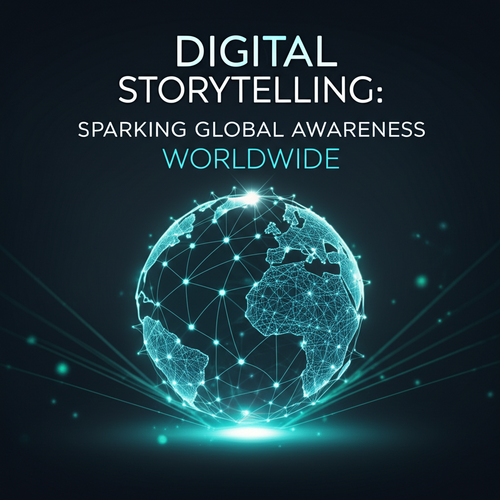Digital Storytelling: Igniting Global Awareness
In an increasingly interconnected world, understanding global issues is more critical than ever. Traditional news cycles once dictated how we perceived events beyond our borders, but the digital age has ushered in a revolution. Now, National Geographic and other platforms are harnessing the power of digital storytelling to transcend geographical boundaries, bringing compelling narratives directly to audiences worldwide. This evolution isn’t just about faster information; it’s about deeper engagement, fostering empathy, and cultivating a more globally aware populace.
Digital storytelling leverages a blend of multimedia—text, images, video, and interactive elements—to craft immersive experiences that resonate deeply. It transforms passive consumption into active participation, making complex global challenges accessible and personal. From climate change documentaries to cultural explorations, this approach is reshaping how we learn about and connect with the world around us.
The Power of Visuals and Immersive Experiences
At the heart of effective digital storytelling lies the power of visuals. High-quality photography and videography can convey emotion, scale, and context in ways that text alone cannot. Organizations like National Geographic have long been pioneers in visual journalism, and their digital presence continues this legacy, offering rich multimedia content that transports viewers to distant lands and introduces them to diverse cultures and ecosystems.
Interactive maps, 360-degree videos, and virtual reality experiences further enhance this immersion. They allow audiences to explore environments, witness events, and even “meet” individuals from different backgrounds, fostering a personal connection that traditional media often struggles to achieve. This immersive approach not only educates but also inspires action, urging individuals to become advocates for global causes.
News Dissemination in the Digital Age
The speed and reach of digital platforms have fundamentally altered how global news is disseminated and consumed. Major news outlets now rely heavily on their digital presence to break stories, provide updates, and offer in-depth analysis. This instantaneous access ensures that critical events—from humanitarian crises to political developments—are broadcast globally in real-time, allowing for rapid awareness and response.
Aggregators like Google News play a crucial role in curating and presenting a vast array of information from countless sources. This enables users to gain diverse perspectives on global events, moving beyond single-source narratives. While this breadth of information is powerful, it also highlights the importance of critical thinking and media literacy in navigating the digital news landscape.
From Breaking News to Deep Dives
Digital storytelling extends beyond immediate news reporting to provide comprehensive deep dives into ongoing global issues. Platforms like CNN often use interactive features, timelines, and multimedia packages to explain complex situations, trace their origins, and explore their potential impacts. These formats help audiences grasp the nuances of international relations, economic shifts, and social movements, making abstract concepts tangible and understandable.
This shift allows news organizations to tell stories that demand more context and background than traditional broadcast segments might allow. By combining expert analysis with compelling personal accounts and visual evidence, digital platforms can create narratives that not only inform but also leave a lasting impression, encouraging continued engagement with global awareness topics.
Engaging Younger Audiences with New Formats
Reaching younger generations with global awareness messages requires understanding their preferred modes of communication. Social media platforms, with their emphasis on short-form, visual, and interactive content, have become pivotal. Snapchat, for instance, has carved out a niche by offering news and educational content in formats native to its platform, such as “Discover” channels and augmented reality (AR) filters.
These platforms turn news into bite-sized, shareable stories, often incorporating elements that encourage participation. Filters and lenses can overlay data or contextual information onto real-world scenes, making abstract global issues feel more immediate and personal. This approach lowers the barrier to entry for engagement, fostering a sense of connection and responsibility among younger digital natives.
The Rise of Micro-Storytelling
Micro-storytelling, often seen on platforms like Snapchat, is about delivering impactful narratives through concise, visually rich snippets. It’s about capturing attention quickly and conveying a core message efficiently. For global awareness, this means distilling complex issues into easily digestible and shareable content, encouraging conversations and disseminating information across peer networks rapidly. While brief, these stories can serve as entry points to deeper exploration, sparking curiosity that leads to more extensive research.
Future Trends in Digital Storytelling for Global Awareness
The landscape of digital storytelling is continuously evolving. Artificial intelligence (AI) is set to play a significant role, from personalizing news feeds to generating synthetic media that can visualize future scenarios or complex data. Imagine AI-powered tools translating content instantly, breaking down language barriers and making global narratives truly universal.
Further advancements in augmented reality (AR) and virtual reality (VR) will create even more immersive experiences. We could soon be “visiting” remote indigenous communities, exploring endangered ecosystems, or walking through the aftermath of a natural disaster, all from our living rooms. These technologies promise to bridge the empathy gap like never before, making global challenges feel acutely real and fostering a profound sense of shared humanity.
Personalized content delivery will also become more sophisticated, tailoring global awareness narratives to individual interests and learning styles. While this offers advantages in engagement, it also presents challenges regarding filter bubbles and the need to ensure exposure to diverse perspectives.
Actionable Takeaways for Fostering Global Awareness
For individuals, cultivating global awareness in the digital age means actively seeking out diverse sources, engaging critically with the content you consume, and participating in online conversations responsibly. Don’t just passively scroll; question, research, and share meaningful stories.
For organizations and content creators, the call to action is to embrace innovative digital storytelling techniques. Focus on authenticity, empathy, and clarity. Leverage visuals, interactive elements, and new technologies to craft narratives that resonate and inspire. Collaborate across borders to tell truly global stories, ensuring that underrepresented voices are heard.
Conclusion
Digital storytelling is more than a technological advancement; it’s a powerful tool for global transformation. By making complex world issues accessible, personal, and engaging, it fosters empathy, encourages critical thinking, and mobilizes action. As technology continues to evolve, the potential for digital storytelling to ignite global awareness and build a more connected, informed, and compassionate world will only grow. It’s an exciting frontier where every click, share, and interaction can contribute to a better understanding of our shared planet and its diverse inhabitants.



